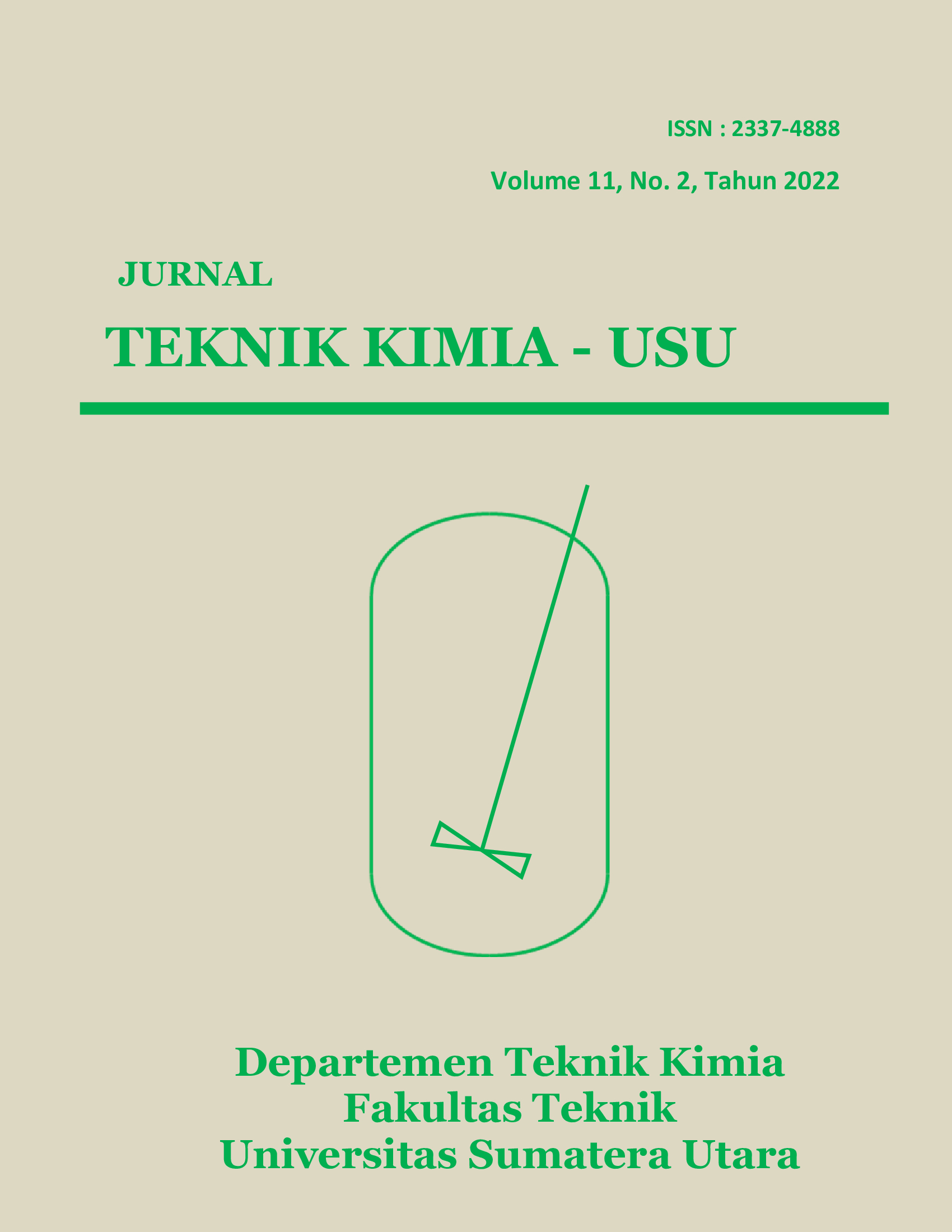Optimasi Pengaruh Waktu Kontak dan Dosis Adsorben Limbah Daun Kayu Putih (Melaleuca cajuputi) dengan Metode Isoterm Adsorpsi Langmuir
DOI:
https://doi.org/10.32734/jtk.v11i2.9119Keywords:
adsorption isotherm, activation, eucalyptus leaf waste, Langmuir adsorption isotherm, malachite greenAbstract
Liquid waste from the textile industry contains harmful dyes that can damage the environment. Pollution to the environment can be minimized by processing dye waste before being discharged into rivers or sewers. The dye waste treatment process can be carried out using the adsorption method. The adsorbent used was non-activated and acid-activated eucalyptus leaf waste (HCl 2 M). The solution used as adsorbate is malachite green. This study aims to optimize the absorbance level of eucalyptus (Melaleuca cajuputi) leaf waste against malachite green dye using the Langmuir adsorption isotherm method. The variables used are the mass variation of the adsorbent, the contact time and the adsorption isotherm model. The absorption efficiency value produced by the adsorbent of eucalyptus leaf waste with 2 M HCl activation was 87.4279%. Meanwhile, the non-activated adsorbent is 86.0290%. For time variations of 10 minutes, 15 minutes and 20 minutes on 2 M HCl activated adsorbent resulted in an absorbance of 0.026; 0.022; and 0.02. Based on the graph of the relationship between Ce and Ce/Qe for the non-activated adsorbent, R2 was obtained at 0.7039 while the 2 M HCl activation was 0.966. So, the eucalyptus leaf waste can be used as an adsorbent without a carbonization process, only needs to be given activation treatment using an acid solution.
Downloads
References
A. Asmara, Y. L. Purnamadewi, S. Mulatsih, and T. Novianti, “Faktor - faktor yang memengaruhi perkembangan investasi pada industri Tekstil dan Produk Tekstil (TPT) Indonesia,†J. Manaj. Teknol., vol. 12, no. 2, 2013.
S. Srivastava, R. Sinha, and D. Roy, “Toxicological effects of malachite green,†Aquat. Toxicol., vol. 66, no. 3, pp. 319–329, 2004.
P. Atkins, Kimia Fisika Jilid 2, Ed. 4, Jakarta : Erlangga, 2013.
A. W. Adamson and A. P. Gast, Physical Chemistry of Surfaces, New York: John Wiley & Sons, Inc, 1997.
P. Ramadhani, R. Zein, Z. Chaidir, Zilfa, and L. Hevira, “Pemanfaatan limbah padat pertanian dan perikanan sebagai biosorben untuk penyerap berbagai zat warna: suatu tinjauan,†J. Zarah, vol. 7, no. 2, pp. 46–56, 2019.
I. Riwayati, N. Fikriyyah, and Suwardiyono, “Adsorpsi zat warna methylene blue menggunakan abu alang-alang (Imperata cylindrica) teraktivasi asam sulfat,†Inov. Tek. Kim., vol. 4, no. 2, pp. 6–11, 2019.
R. Helfiansah, H. Sastrohamidjojo, and Riyanto, “Isolasi, identifikasi dan pemurnian senyawa 1,8 sineol minyak kayu putih (Malaleuca leucadendron),†ASEAN Journal of Systems Engineering, vol. 1, no. 1, pp. 19–24, 2009.
E. Ghasemi and M. Kaykhaii, “Application of micro-cloud point extraction for spectrophotometric determination of malachite green, crystal violet and rhodamine B in aqueous samples,†Spectrochim. Acta Part A Mol. Biomol. Spectrosc., vol. 164, pp. 93–97, Jul. 2016.
L. A. M. Ali, A. S. Farhood, and F. F. Ali, “Technique of batch adsorption for the elimination of Malachite green dye from industrial waste water by exploitation walnut shells as sorbent,†Indones. J. Chem., vol. 17, no. 2, pp. 211–218, 2017.
F. Sholehah, “Adsorpsi zat warna malachite green dan congo red dengan menggunakan silika mesopori MCM-48,†Tesis, Universitas Hasanuddin, Makasar, 2022.
H. Susanto, Budidaya dan Penyulingan Kayu Putih. Yogyakarta: Kanisius, 2003.
N. Muharyani, “Potensi penanganan limbah daun kayu putih sisa penyulingan di PMKP Krai-Gundih,†Risal. Kebijak. Pertan. DAN Lingkung. Rumusan Kaji. Strateg. Bid. Pertan. dan Lingkung., vol. 7, no. 1, pp. 28–36, 2020.
R. C. Bansal and M. Goyal, Activated Carbon Adsorption, Boca Ronton: CRC Press, 2005.
S. Harahap, “Pemanfaatan ampas tebu sebagai adsorben zat warna methylene blue dan malachite greenâ€, Skripsi, Universitas Islam Negeri Syarif Hidayatullah, Jakarta, 2018.
Harminta, Analisis Kuantitatif Bahan Baku Dan Sediaan Farmasi, Edisi ke-1. Depok: Departemen Farmasi FMIPA-UI, 2006.
W. L. McCabe, J. C. Smith, and P. Harriott, Unit Operations of Chemical Engineering, 7th ed. New York: McGraw-Hill, Inc, 2005.
N. Nurhasni, F. Firdiyono, and Q. Sya’ban, “Penyerapan ion aluminium dan besi dalam larutan sodium silikat menggunakan karbon aktif,†J. Kim. Val., vol. 2, no. 4, 2012.
D. H. A. Sudarni et al., “Malachite green removal by activated potassium hydroxide clove leaf agrowaste biosorbent: characterization, kinetic, isotherm, and thermodynamic studies,†Adsorpt. Sci. Technol., vol. 2021, 2021.
M. Shofiyuddin, “Adsorpsi malasit hijau menggunakan batang jagung termodifikasi asam sitrat dengan variasi pH,†Antimicrob. Agents Chemother., vol. 58, no. 12, p. 49 pages, Nov. 2020.
D. Y. N. Kakame and A. D. Wuntu, “Degradasi dan adsorbsi zat warna methylene blue menggunakan komposit Ag-tulang ikan terkalsinasi,†Chem. Prog., vol. 11, no. 2, pp. 58–62, 2019.
N. Nurhasni, H. Hendrawati, and N. Saniyyah, “Sekam padi untuk menyerap ion logam tembaga dan timbal dalam air limbah,†J. Kim. Val., vol. 4, no. 1, 2014.
T. Huda and T. K. Yulitaningtyas, “Kajian adsorpsi methylene blue menggunakan selulosa dari alang-alang,†IJCA (Indonesian J. Chem. Anal., vol. 1, no. 01, pp. 9–19, 2018.
Downloads
Published
Issue
Section
License
Copyright (c) 2022 Jurnal Teknik Kimia USU

This work is licensed under a Creative Commons Attribution-ShareAlike 4.0 International License.

















